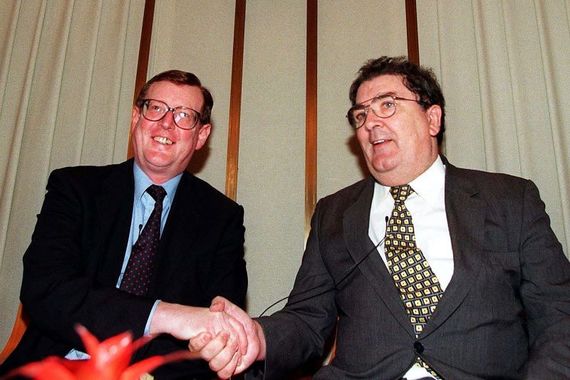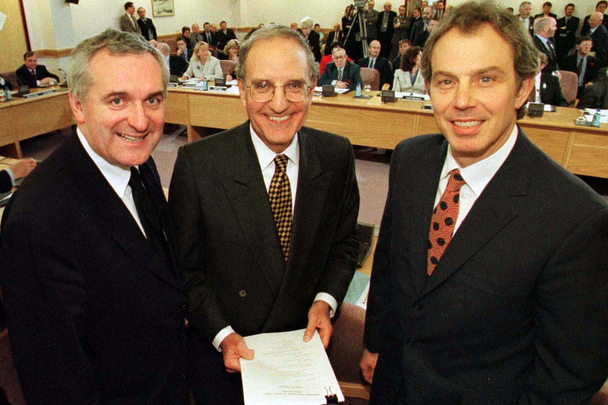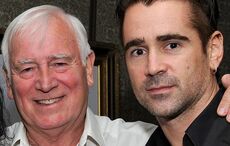Today, April 10, 2025, is the 27th anniversary of the signing of the Good Friday Agreement.
Marking the anniversary of the Good Friday Agreement, also known as the Belfast Agreement, Ireland's Tánaiste and Minister for Foreign Affairs Simon Harris described it as "a remarkable achievement, a document that married political vision and compromise."

British Prime Minister Tony Blair and Irish Taoiseach Bertie Ahern signing the Good Friday Agreement on April 10, 1998. (RollingNews.ie)
Harris said that credit for the Good Friday Agreement goes "first and foremost, to the people of Northern Ireland – political leaders, civil society, citizens – who decided to make a new beginning and build a different future, free from violence."
Harris went on to say that the Agreement could not have happened without support from outside Northern Ireland.
"Progress on the most difficult issues has often depended on a positive relationship between the Irish and UK governments in our capacity as co-guarantors of the Good Friday Agreement," he said.
"I know that the reset in our relations will offer that once again."
He also acknowledged the support of international partners: "There are too many to mention, but bipartisan support from the US has been indispensable, and the EU played a vital role, both in direct support to the peace process and as a shared framework for the peace that followed."
On this day 27 years ago, the Good Friday Agreement was signed. This remarkable document – made possible by political leadership, vision, and compromise – helped end a cycle of violence that had continued for 30 years on the island of Ireland. Learn more: https://t.co/5PZgRKfu8X pic.twitter.com/UjXsuoQCkQ
— Irish Foreign Ministry (@dfatirl) April 10, 2025
Harris continued: "No peace agreement can immediately resolve all issues and we have to be honest in acknowledging that there is a way yet to travel. The promise of reconciliation in the Agreement is the work of generations.
"How to address the legacy of the Troubles is a crucial question. I am looking forward to meeting Secretary of State for Northern Ireland, Hilary Benn, at Hillsborough Castle on 24 April, where we will discuss that subject, among others.
"It can be easy to become discouraged when we encounter obstacles, or when we see the ways in which Northern Ireland and this island remains divided.
"However, today is a moment to celebrate the great strides we have made. There is political progress: the return of stable, locally elected and accountable government to Northern Ireland, and to all island cooperation through the North South Ministerial Council.
"Most of all, today is a moment to pause and not take for granted how life has changed for the people of Northern Ireland, and to celebrate that: greater prosperity, all the friendships and relationships that might never have been, and all the lives saved."
Read more
Benn also paid tribute to the Good Friday Agreement's anniversary on Thursday.
"It was courageous political leadership that brought about the signing of the Good Friday Agreement 27 years ago today," he said in a post on social m media.
"As we mark that extraordinary moment, let us remember how the peace process has transformed the political and economic life of Northern Ireland for the better."
It was courageous political leadership that brought about the signing of the Good Friday Agreement 27 years ago today. As we mark that extraordinary moment, let us remember how the peace process has transformed the political and economic life of Northern Ireland for the better. https://t.co/pd31TqQLHQ
— Hilary Benn (@hilarybennmp) April 10, 2025
What is the Good Friday Agreement?
The Good Friday Agreement was signed on Friday, April 10, 1998 - Good Friday - and effectively brought an end to the period of conflict in the region known as The Troubles.
The two main political parties to the Agreement were the Ulster Unionist Party (UUP), led by David Trimble, and the Social Democratic and Labour Party (SDLP), led by John Hume. Sinn Féin, the Alliance Party, and the Progressive Unionist Party also supported the agreement, while the Democratic Unionist Party (DUP) did not.

David Trimble and John Hume. (RollingNews.ie)
Talks surrounding the agreement were chaired by US Senator George Mitchell, who was sent by US President Bill Clinton.
The Good Friday Agreement created power-sharing in Northern Ireland with the creation of the Northern Ireland Assembly and the Northern Ireland Executive, ending decades of direct rule from London.
The historic agreement recognized that the majority of Northern Irish people wanted to remain in the UK, although it also recognized that a substantial section of the region wished for a United Ireland.
It also recognized the legitimacy of any choice made by the people of Northern Ireland to either continue as part of the UK or become part of a United Ireland. In essence, the Agreement included the provision for a referendum on a United Ireland on both sides of the border if the Northern Ireland Secretary believes that a majority of voters would vote in favor of a United Ireland.
Contentiously, the Agreement allowed for the release of nationalist and loyalist terrorists who were sentenced before April 10, 1998.
It also allowed Northern Irish residents to identify as British or Irish, or both.
The Good Friday Agreement also created several north-south and British-Irish institutions to ensure continued peace in Northern Ireland.
Additionally, the Agreement created open borders between Ireland and Northern Ireland void of any checkpoints.
After being signed on April 10, the Agreement was put to a referendum both north and south of the border on May 22 - ultimately, 71% supported it in Northern Ireland while 94% supported it in Ireland.
You can read the full text of the 35-page Good Friday Agreement here.




Comments